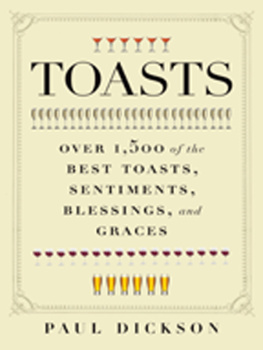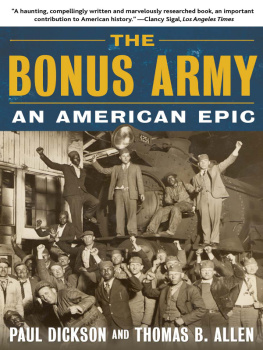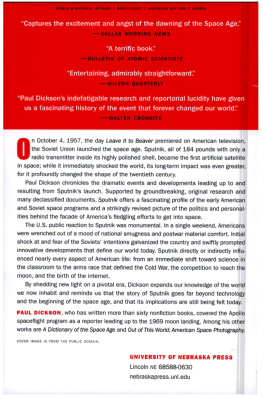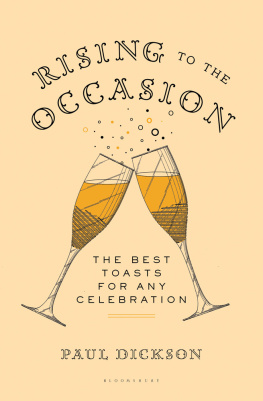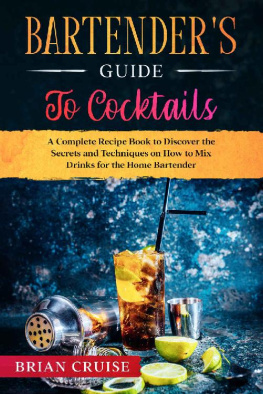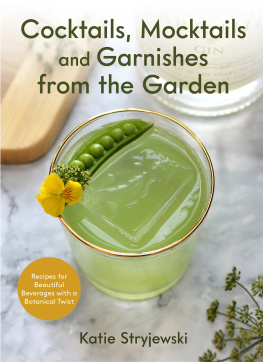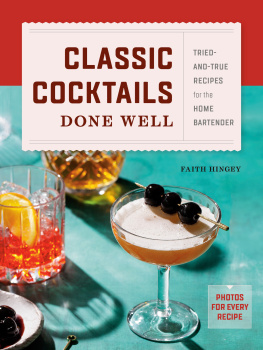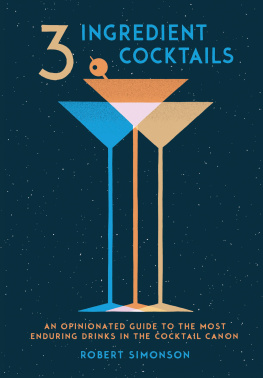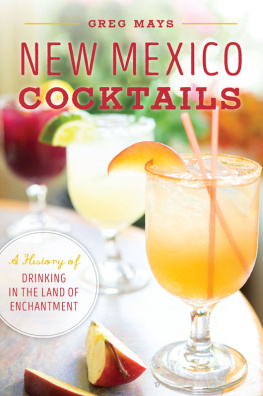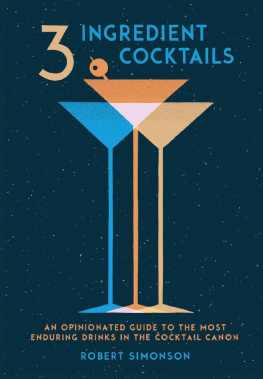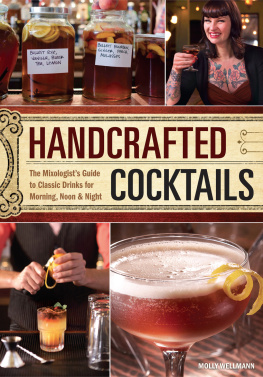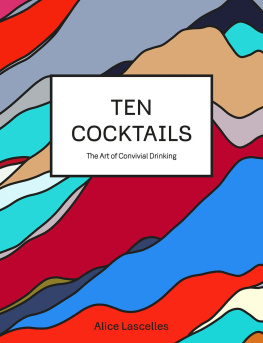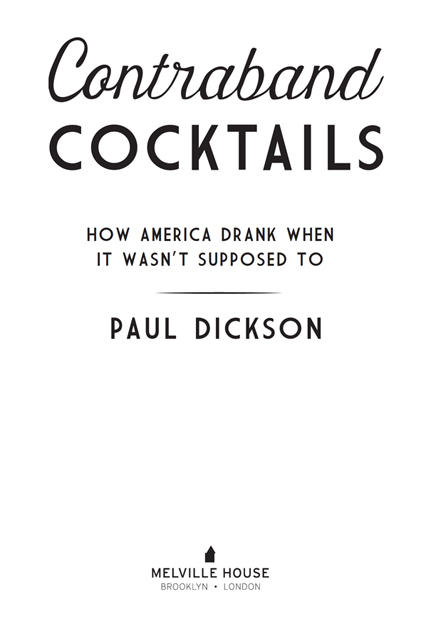CONTRABAND COCKTAILS
Copyright 2015 by Paul Dickson
First Melville House printing: November 2015
Grateful acknowledgment is made to the Library of Congress for permission to reprint photographs from their archive.
Melville House Publishing
46 John Street
Brooklyn, NY 11201
and
8 Blackstock Mews
Islington
London N4 2BT
mhpbooks.com facebook.com/mhpbooks @melvillehouse
Library of Congress Cataloging-in-Publication Data
Dickson, Paul, author.
Contraband cocktails : how America drank when it wasnt supposed to / Paul Dickson.
pages cm
Includes bibliographical references.
ISBN 978-1-61219-458-5 (hardback)
ISBN 978-1-61219-459-2 (ebook)
1. Cocktails. 2. CocktailsUnited StatesHistory. I. Title.
TX951.D499 2015
641.874dc23
2015030030
Design by Adly Elewa
v3.1
CONTENTS
PREFACE
Much has been written about Prohibition in the United States (19201933), but precious little has been written about the paradoxical rise of the cocktail and the stylish, urbane cocktail culture that began to flower on the very dateJanuary 16, 1920when mixed drinks and all other forms of alcohol became illegal.
This book attempts to remedy the situation with a discourse on Prohibition cocktails followed by an annotated formulary of drinks from the Dry Years, including many drinks that were created during the period by expatriate American bartenders.
Almost a hundred years after the fact, Prohibition still holds a deep fascination for Americans. At the most superficial and visible level, it survives in the many Prohibition Era faux speakeasies that dot the landscape. The speakeasy revival began in the late twentieth century with an occasional novelty, and continued to rise steadily through to the first decade of the twenty-first century, at the end of which it boomed.
Take the city of Boston. As of this writing, it had a dozen Prohibition-themed bars and restaurants, such as the Carrie Nation Restaurant and Bar, which opened in 2013. The Carrie Nation is on the block next to the Massachusetts State House on Beacon Hill, one of the forty-six locations where the Eighteenth Amendment to the Constitution that banned alcohol was ratified. Around the corner, theres a bar across from the State House known as the Twenty-first Amendment, which alludes to the Constitutional Amendment that repealed Prohibition. It is next to the apartment building where John F. Kennedy lived when a bachelor.
There is fascination abroad as well. Taking inspiration from Americas Prohibition era, the London Town webpage reported in 2014, London is currently brimming with elusive bars hidden behind unmarked doors and unassuming entrances. With cocktails in teacups, suave jazz and glamorous dress codes, they invite those in the know to intimate yet raucous evenings. So, dust off your dancing shoes and dig out your map as London invites you into an underground world of illicit drinking.
The trend seems to have been first spotted in 2009 when the trade magazine Restaurant Business noted the seemingly counterintuitive strategy of marketing an establishment by making it hard to find, but thats what is being done by a growing number of bars and lounges. Modern-day speakeasies, the magazine reported, dont put up any signage, have unlisted phone numbers, require passwords and are often found behind secret entrances down shadowy alleys. Just as New York was the speakeasy capital during Prohibitionepitomized by the 21 Clubthe modern trend began there but the phenomenon is spreading to other cities.
Todays speakeasy is the bar as cinema, was one explanation given in the magazine Art Culinare in 2010. It invites customers to become actors in a flickering movie from a nostalgic part of our collective history. Like the forbidden allure of an opium den, the modern speakeasy is a lush and dreamy stage of punched tin ceilings, dark wood paneling and potions swirling in glasses made luminous by the velvet light of flickering candles. Atmosphere is not the twenty-first-century speakeasys only enticement. The drinks featured tended to be of the period harking back to a time when sipping a Manhattan, Bronx, or a Mary Pickford carried with it the titillating risk of getting caught.
Coinciding with this came the aromas and flavors of the Dry Years. Bathtub gin and raw rye whiskey from tidewater stills were reincarnated as small-batch gins and ryes. Bitters and high-end tonics and mixers were coming into play finding new markets.
The quality of life around the bar improved when speakeasies reemerged a few years back. Food editor Devra First wrote in The Boston Globe in August 2014: The trend has brought us better bartending and ingredients; it has restored to prominence delightful drinks we seldom got to enjoy and birthed plenty of new ones.
Conveniently overlooked in this neo-speakeasy movement is the fact that the new joints feature drinks made
Meanwhile, the same urge that has given us the twenty-first-century speakeasy has also given us a revival of interest in shakers, hip flasks, and the hardware trappings of Prohibition. Walk into any Pottery Barn and youll find a Speakeasy Collection inspired by the vintage barware of the era. And mens clothier J. Crew offers a speakeasy hip flask with the come-on: Channel speakeasy-era panache with our leather-bound flask, a throwback to the heyday of discreet drinking.
Amazon.com offers dozens of hip flasks, including one described as a Personalized Engraved Cross, Jesus, Christian 12 Oz Stainless Steel Pocket Hip Drinking Flask for Men and Women, as well a four-ounce flask hidden inside the cover of a Holy Biblenovelties that would have been most offensive to those elders of the Protestant denominations of the Prohibition Era who sought to have all references to wine expunged from both the Old and New Testaments by turning the references of wine to grape juice.
Reminders of the era abound in popular culture, where the Dry Years have their own solid niche, having given rise to a generation of romantic charactersthe flapper, the private eye, the organized crime boss, the corrupt enforcer, the bootlegger, and the rumrunnerwho live on in various media. Not only, for example, does The Great Gatsby hang on into the present, but it has been made into four Hollywood films (1926, 1949, 1974, and 2013) and one made-for-television film (2000).
There is even an emerging archaeology of Prohibition as entrepreneurs seek old speakeasy sites to be given new life. In 2013the eightieth anniversary of Repeala collaboration between Preservation Detroit and the Wayne State University Department of Anthropology uncovered the existence of an illegal Prohibition-era speakeasy beneath Tommys Detroit Bar & Grill at 624 3rd Street. It was rumored that the original speakeasy had ties to the infamous Purple Gang and other underworld organizations. Also in 2013, the Dayton Daily News reported that it had discovered the existence of an unusually decorated basement room in an East 3rd Street commercial building, which fits the long-running local legend about a hidden piece of downtowns Prohibition Era history. This room was part of a network of speakeasies reachable through underground steam heating tunnels crisscrossing downtown.
But before the cocktail hour arrives, let us take a look at the subject through the prism of one real charactera bone fide bootleggernamed George L. Cassiday, remembered by the color of his fedora. Perhaps more than any other single individual, he served to exemplify and, ultimately, undermine the folly of the era.


